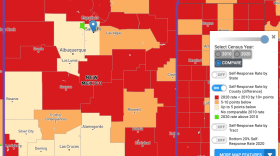After COVID-19 hit, federal officials initially gave extra time to Census collectors to count every person living in the United States. But then they decided to end the survey a month early, increasing the risk of an undercount that could cause New Mexico to lose out on hundreds of millions of dollars for housing, food assistance, childcare, transportation and more. Native Americans living in rural areas are historically undercounted, and the pandemic has made data collection even harder. Reporter Shaun Griswold, who publishes at New Mexico In Depth for Report for America, has been keeping an eye on how the Census is reaching Native populations in the state and he gave KUNM an update on that process.
Shaun Griswold: 78% of Indigenous and Native American people live in urban settings like Albuquerque, like Gallup Farmington, Las Cruces. So while New Mexico is known for its 23 tribes, the majority of that population actually lives in the city.
KUNM: Why is Census collection extra challenging in Native American communities?
Griswold: This year, the most significant impact has been the access to tribes. So the Census, in collaboration with the tribes, set up what they called update leave. Many tribal nations don't have physical addresses, so the idea was, we're going to drop off this specific packet that has a specific identification number that's geotagged to the location of your home. This started the same week that COVID started to hit across the country. So, tribal restrictions that are currently still in place don't allow visitors to come in, so many tribal nations across the country and particularly in New Mexico had some of the lowest Census rates because they didn't receive what the Census called their invitation to participate. Some of them got their invitation less than three weeks ago. And this was the effort by the Census, encouraging people to not fill it out in the traditional way. Like, if you live in a city, you can go online, you can call, you could mail it in. The people who live in rural communities and tribal communities were told to wait until they receive their packet at their door.
KUNM: Have you heard about any new or creative approaches to getting an accurate count in tribal communities, or for urban Native Americans?
Griswold: We're seeing advertisements everywhere, radio, print, broadcast, the internet now. That's actually one that I was listening to strategies that the city of Albuquerque is using when it comes to some of their counts. They're able to identify particular zip codes where there's low response rate, and they're able to create targeted online ads to those areas. So like, you know, let's say you're in the International District, and the zip code has a low response rate. You pick up your phone, you may have an ad that tells you and reminds you to fill out the Census just because of the location of where you are.
There's been a conversation among some state leaders and some tribal leaders, and in fact I had this conversation with Representative Derrick Lente a couple weeks ago, that could look to get a complete count or at least the most accurate count on tribal communities. Groups are trying to organize a memorandum of understanding with tribal communities to use tribal entity data to identify how many people actually live within the tribe. Now when I say that I'm talking about housing data, I'm talking about utility data, tribal enrollment numbers. Rep. Lente, in the conversation, he said he supported this effort, and in fact said that especially in times of COVID with the restrictions of who can go in and who can go out of these communities, this could potentially be a solution to the undercount that's sort of being expected.
KUNM: The timeline for the Census was expanded because of COVID-19, and then shortened again. Now there's just over a month left until the latest Census deadline. Where do we stand with the count in New Mexico and in tribal communities, and how does that compare with expectations?
Griswold: So the expectation is 100%. New Mexico is actually below the national average. The national average response rate is at 64%, and New Mexico is at 54%. Albuquerque and Bernalillo County, they're above the national average. Albuquerque is at 68%. So, the city is doing pretty well right now. Now, tribal communities have caught up significantly: Santo Domingo Pueblo, Jemez Pueblo, Cochiti Pueblo, those are the three highest tribal communities that have returned their Census responses. And in fact, they're above the state average right now.
But again, if you look through the list, you're seeing kind of across the board and particularly the Navajo Nation - now this is the largest tribal community in the country - and the Navajo Nation right now has a 17% response rate. There's a lot of homes that are miles apart, I mean there are some home developments in areas that are in clusters, but there's still a lot of individuals who live in a very remote location and that's why the Census is hoping they can hire individuals who are from the communities, because they feel like these individuals understand the geography and the layout, more than anybody who's from the outside would.







